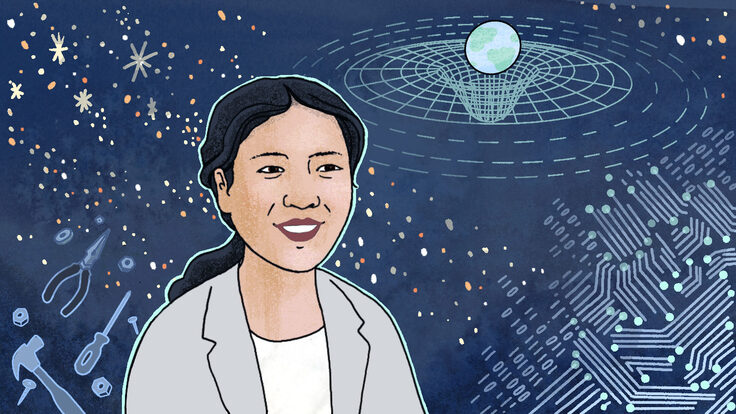Danielle Hodgkinson watched with cautious curiosity as the data poured onto screens in the control room for the ALPHA experiment. The ALPHA team was working to observe an effect that had never been observed before.
“It was exciting,” says Hodgkinson, a postdoc at the University of California, Berkeley. “But extensive data analysis was required before we concluded the final result.”
After several months of analysis and cross-checks, Hodgkinson and her colleagues were able to confirm their initial inklings: For the first time, they had shown that antimatter, when dropped, falls down. Their results were published today in Nature.
Antimatter is identical to matter, except that some of its properties are flipped. For instance, electrons are negatively charged, but their antimatter counterparts, positrons, are positively charged.
Matter and antimatter annihilate when they meet, and this presents physicists with a puzzle. Theoretical models predict that, in the moments after the Big Bang, the amount of matter and antimatter should have been equal. So why didn’t they cancel one another out completely? How are we still here?
“It’s one of the big outstanding questions in physics,” Hodgkinson says. “We don’t understand why matter and antimatter didn’t annihilate in the early stages of the universe. Instead, we’re able to live in a seemingly matter-dominated universe and think about these things.”
ALPHA, an experiment at the Antimatter Factory at CERN, looks for minute differences between matter and antimatter that could explain how matter won out over antimatter in the early universe. Thus far, matter and antimatter seem to be either equal or mirror images of each other in all areas. “Antimatter is a very specific reflection of matter,” Tharp says. “Some things are the opposite, and some things are the same.”
But one area that hadn’t been fully investigated is how antimatter interacts with gravity. “A difference in the behavior would be a completely unanticipated result and would change our understanding of physics,” Hodgkinson says.
For a long time, this was an almost impossible measurement. “There was no good test particle,” she says. “The gravitational force is much weaker than the electric force, so it’s necessary to run the test with an electrically neutral particle.”
Electrically neutral antihydrogen was the ideal candidate. But producing (and trapping) antihydrogen came with its own difficulties. This is where ALPHA excelled. ALPHA’s original mission was to produce and trap antihydrogen atoms using antiprotons from CERN’s antimatter decelerator. “CERN is the only place in the world that provides low-energy antiprotons,” says Joel Fajans, a professor at UC Berkeley.
ALPHA creates antihydrogen by confining two plasmas of very cold particles—one of positrons and one of antiprotons—inside an M-shaped electromagnetic trap. Then, they slowly bring the arches of the “M” together, forming antihydrogen.
Electric fields are invisible to electrically neutral particles like antihydrogen. But the spinning positron of an antihydrogen atom makes it act like a tiny bar magnet, still sensitive to magnetic fields.
To trap the antihydrogen, the scientists on ALPHA created an incredibly strong magnetic field. “It’s like a magnetic bathtub,” Tharp says.
If antihydrogen atoms are cold enough (and thus slow enough), they can lock onto the magnetic bathtub’s field lines and coast around the interior of the trap without escaping.
Once ALPHA mastered the process of creating and trapping antihydrogen, then came the question: What properties can we measure? Berkeley theorist Jonathan Wurtele had an idea: “For six months, Jonathan would come into my office once a week and say, ‘Let’s do gravity,’” Fajans says. “I’d tell him, ‘It’s not possible, go away.’”
Finally, Wurtele convinced Fajans, and Fajans convinced his collaborators on ALPHA to give it a go.
“This is the first Leaning Tower of Pisa experiment with antimatter,” says Tim Tharp, an associate professor at Marquette University, referring to Galileo’s fabled experiment dropping objects from the leaning tower to compare their rates of acceleration.
In 2013, ALPHA looked at how the trapped antihydrogen fell when they turned the trap off.
But their results couldn’t answer that question. “If the gravitational acceleration of antimatter is the same as matter, we should get the result of plus 1 g; if it is opposite, minus 1 g,” Tharp says. “In that first experiment, it was narrowed down to having a value between about plus-or-minus 100 g.”
The problem with the first experimental set-up was that simply turning off the trap was a chaotic event. “It’s like filling a balloon with hydrogen gas and then popping it,” Tharp says.
The team realized they needed more finesse if they wanted a more precise answer. “We started designing a more serious attempt,” Fajans says.
In 2018, with funding from the National Science Foundation and the US Department of Energy, they started building the latest version of the experiment, ALPHA-g. In this rendition, they wanted to turn the trap off slowly, making it weaker and weaker until antihydrogen atoms started to escape. If gravity were pulling the antimatter down, the antihydrogen atoms would have a slightly higher probability of escaping the trap at the bottom. And if gravity were doing the opposite, they would see more atoms escaping through the top.
A big challenge was accounting for all the experimental uncertainties. “The gravitational potential is really small,” Hodgkinson says. “If the magnetic field uncertainty becomes comparable to the small gravitational potential, then we have an issue.”
The team needed a deep understanding of the shape and structure of their magnetic trap. This meant getting a detailed view of their magnets. “We took pictures of every layer of the magnets as they were being wound at Brookhaven National Laboratory,” Hodgkinson says. “Then we had to model every single wire in every single magnet.”
The whole apparatus contains about 30 magnets. Knowing the location of each wire allowed the scientists to calculate the total magnetic field in the trap, which they used to create a simulation of the experiment. When the simulation and experiment were ready, they started the trials.
First, they tested their trap’s capabilities by implementing a strong magnetic bias. “We wanted to see if we can push all antihydrogen up, and if we can push all antihydrogen down,” Hodgkinson says. “We could, and so from that point, we needed to increase the sensitivity.”
The scientists then modulated the strength of the trap at the top and bottom. “It’s like a magnetic balance,” Fajans says. “If we put 1-kilogram weights in each pan of a balance, they stay at the same height. But if we add just 1 gram to one side, that pan will go down.”
The idea was to find the balance point: the magnetic bias at which antihydrogen escapes from the top and bottom of the trap at the same rate. This balance point would reveal if (and how) gravity might be tipping the scales. They ran 13 iterations of the experiment, each with different magnetic biases.
“The best fit to our measurements yields a value of (0.75 ± 0.13 (statistical + systematic) ± 0.16 (simulation)) g for the local acceleration of antimatter towards the Earth,” the collaboration states in their latest paper. “We conclude that the dynamic behaviour of antihydrogen atoms is consistent with the existence of an attractive gravitational force between these atoms and the Earth.”
These results are yet another confirmation of Albert Einstein’s theory of general relativity.
“We don’t know everything there is to know about gravity,” Tharp says. “We have this image that gravity warps spacetime. If antimatter fell the opposite way, that picture wouldn’t fit anymore. These results are a new, substantial piece.”
Einstein winning is not surprising to the physics community. But Fajans notes that before this experiment, there was still room for doubt. “There was a small but steady stream of papers from physicists at respectable institutions that made predictions about our universe and galaxy that relied on gravity being opposite for matter and antimatter,” Fajans says. “It seems like we foreclosed all of those theories.”
Even though ALPHA has shown that antimatter falls down, the precision is too low to know if antimatter and matter experience gravity with the same strength. The next step is to improve the precision and study exactly how gravity impacts antimatter.
“Any discrepancy here would completely revolutionize physics,” Fajans says. “The great thing about doing this is that if we get a positive result, it’s a brave new world: the most exciting discovery in physics in the last 50 years. It’s certainly worth doing.”







